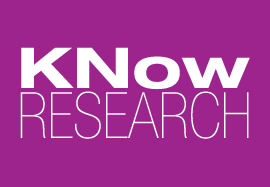Mining Social Media for Qualitative Insights
If I were to boil down what the mission is as an insights professional, it is to uncover the truth(s) about a human story as it relates to the topic at hand. In a word: truth-seeking. This curiosity drew me to the field of consumer insights, and much of the satisfaction I still get conducting studies comes from the limitless possibilities to gain that understanding each time through a new lens.
At KNow Research, we operate with a constant curiosity and open-mindedness on how to best answer our clients’ questions. Researching research to find the best methodologies to include in our toolboxes is part of what we do.
The most recent step on our methodological journey this year was to add social media research to our offerings. We felt the breadth of conversations happening on social media was something valuable to harness for our clients, we just need to figure out how!
I was familiar with social media research in my past years working at media agencies and TV networks. Usually these were standalone initiatives to learn about a particular topic for a client via social listening, or to understand TV social engagement and category indexing to showcase the value of our viewing audience for prospective advertisers. It was time to dust off the cobwebs on social to see what was available today, and how those tools might complement our research methodologies.
Enter our client, Financial Gym, a personal financial services company that takes a fitness-inspired approach to their clients’ finances. We selected them as our 2020 pro-bono project recipient after they came to us with some pressing questions in the wake of the pandemic, which shook up pretty much every industry, but finance in particular.
We stepped in to help them learn from their prospective customers, despite not being able to be out on the road talking to people in person like we typically would.
The goal was 3-fold:
- Deliver targeting strategies for potential Financial Gym customers
- Inspire messaging/marketing strategies to attract these customers
- Fine-tune and/or expand Financial Gym’s service offering
We began with our Booth™ Insights methodology, which mimics the spontaneity of in-person intercepts, but allows for a wider net of a target audience to be reached in a much shorter timeframe online. We were able to speak with 30 people in just four hours via an online video platform, in 15-minute intervals, connecting with them on their personal finance worries, needs, priorities, and what a company could do to serve them best.
What we learned from qualitative interviews:
- People want to feel in control of their money – especially during turbulent times like we’ve seen this year. The way participants have been doing this is by being more proactive about saving, paying down debts, curbing spending and adopting new budgeting tools.
- Their financial needs, goals and experience varied greatly by life stage; while older participants often already had their financial systems in place and were more self-sufficient, younger ones were the most unaware and seeking knowledge to ‘get into the game’, desiring knowledge around managing personal finances to feel more secure.
- People don’t turn to professionals right away, but instead scan the landscape of trusted connections and free resources online, which was often through friends, family and Google-searching topics and resources like budgeting tools, apps and spreadsheets.
- Most were open to a paid service that provided tailored education and investment action around their goals, so long as they could clearly see the value without risk.
- WATCH our video playlist of qualitative findings HERE
We concluded that for Financial Gym, a tiered model based on one’s life stage, goals, desired level of hands-on service and financial abilities – with a free trial to start – was the clear product outcome.
We could have stopped there, of course – we had rich, qualitative feedback on the topic of personal finance management, and the client was able to move forward with a new digital, tiered approach to their services with confidence. But we wanted to cast an even wider net to see if these qualitative conversations mirrored the views of the larger population, and to see what else we might be able to learn that wasn’t a direct response to our questions from the discussion guide.
We had to first narrow down what our need was, which we determined fell into the realm of social listening. We wanted to explore how people discuss managing their finances more broadly. However, we learned in the process that there is so much more that social media data can reveal, from audience segmentation, evaluating influencers and measuring a brand’s social platform performance.
After exploring a handful of individual social media tools, and even giving one a spin for a month, I was reminded of the steep learning curve that’s involved in becoming seasoned in any one social tool and query development to obtain the right data. While possible, it can be a time-consuming endeavor!
Fortunately, we learned about NorthStar Solutions Group after attending their presentation on how social media can be leveraged by research companies. They met with us and explained the tools they subscribe to and levels of service they offer on a project-by-project basis for social analysis. Through them, we were able to leverage the Talkwalker platform and cast that wider net by listening to conversations on social channels over the past 24 months. In this case, they did the heavy lifting with query development and setting up custom dashboards, while we got to do what we do best – analyzing rich qualitative data and mine for insights.
What our social learnings added:
- Verifying the core theme from our qualitative about the desire for control on a large scale
- A timeline trajectory of peoples’ sentiments and actions they took around their personal finances, which began with fear and uncertainty in March and transitioned by Summer into proactive actions they began taking
- Validating Financial Gym’s core age bracket of 21-34-year-olds, and even slightly younger, but with the added emphasis on parents who are especially engaged with the topic online
- Revealing where in the U.S. topic engagements and conversations were most happening, which were in more regions than Financial Gym’s targeted scope
- Specific examples of the types of content and resources people engage with online; the strongest social catalysts (articles, videos or posts that generate the most likes, conversations, shares or retweets) were independent purveyors of advice – often amateurs – who generate traction with free empowering ‘how-to’ videos and apprise people of timely events in the market
- Insight into specific tools people discovered and seemed excited about later in the pandemic, like Robinhood, which were featured in articles that gained some of the most social and viral traction.
In sum, through social analysis, we were able to add new learnings for Financial Gym on two of the three topics they were curious about in the broader scope of personal finance management, while adding scale and validation to our qualitative findings:
- Delivering refined targeting strategies for potential Financial Gym customers
- Inspire partnerships, messaging and placement strategies to attract these customers
From this experiment, social media research has earned its place amongst our offerings. We’re excited to bring more clients closer to their customer by listening, realizing the breadth and depth it can reveal. We were also happy to know that primary research serves a purpose that social cannot replace; asking the more specific questions that a business is looking to understand.
Both methods have unique benefits as well as complementary ones that can make either method useful solo, or supercharged when used interdependently.
Read our full case study HERE, and let us know your thoughts on the combination of qualitative and social insights!

